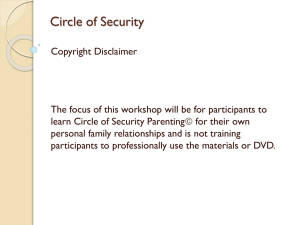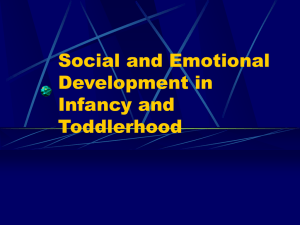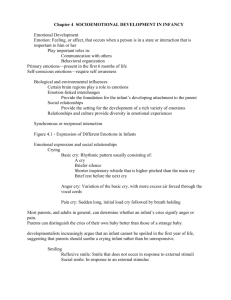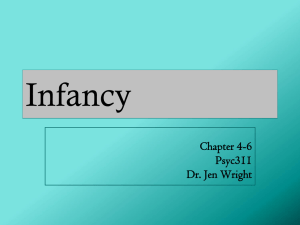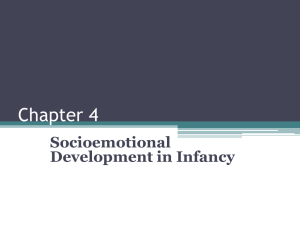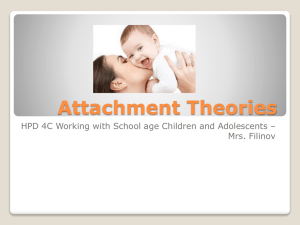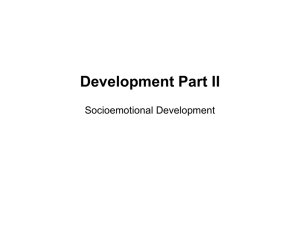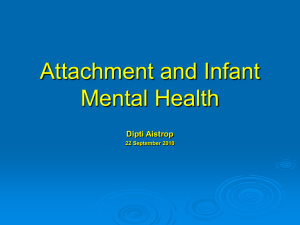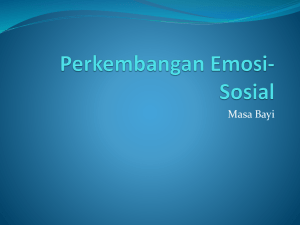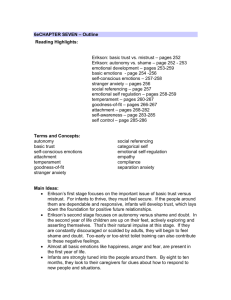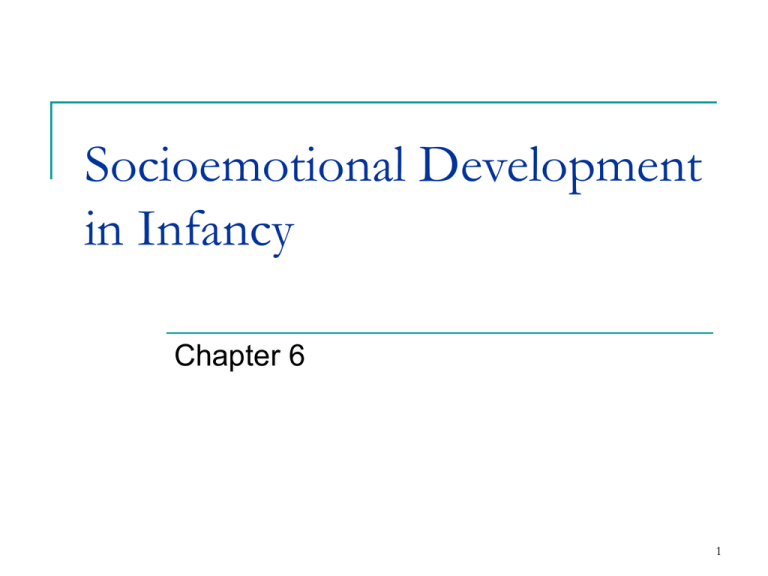
Socioemotional Development
in Infancy
Chapter 6
1
EMOTIONAL DEVELOPMENT
Basic emotions, such as happiness,
interest, surprise, fear, anger, sadness, and
disgust, are directly inferred from facial
expressions.
An emotion or affect that can involve
physiological arousal, conscious
experience, or behavioral expression
2
What is the emotional state of this baby?
Carroll Izard’s MAX System can be used to code
3
Emotions emerge in sequence
Social smile
Anger, surprise, sadness
Evoked by the stimulus of the human face
First appears between 4 and 6 weeks
First appears around 3 to 4 months in response
to active stimuli.
Shame: 6 to 8 months
Contempt: 2 years
4
Negative Emotions
Anger is expressed during the first months when
babies cry in response to unpleasant
experiences (4-6 months).
Expressions of sadness are usually less
frequent than anger.
Fear rises during the second half of the first
year.
cause and effect
stranger anxiety
5
Why is this baby crying?
Could be out of anger, pain, or unknown
reasons
6
Can babies imitate emotions? (Meltzoff)
7
Understanding and Responding to the
Emotions of Others
Emotion Contagion (birth)
Social referencing (~1 year)
Infant relies on a trusted person's emotional
reaction in an uncertain situation.
By toddlerhood, children use emotional
signals to infer others’ internal states and
guide their own actions.
8
Emergence of Self-Conscious
Emotions
At the end of the second year (18-24
months)
Child needs to have a self-concept
Injury to or enhancement of the sense of
self
Embarassment, guilt, envy, pride
Helps children to acquire values of society
9
Beginnings of Emotional Self-Regulation
Emotional self-regulation refers to the strategies used to
adjust emotional states to a comfortable level of intensity.
Infants have only limited capacity to regulate their
emotional states.
By the end of the first year, babies’ ability to move around
permits them to regulate feelings more effectively by
approaching or retreating from various stimuli.
End of lecture 1
11
TEMPERAMENT AND DEVELOPMENT
Temperament
stable individual differences in quality and
intensity of emotional reaction, activity level,
attention, and emotional self-regulation.
New York Longitudinal Study (Thomas &
Chess, 1956) indicates
Temperament predicts adjustment.
Parenting can modify emotional styles.
12
Structure of Temperament
Easy child (40%)
Difficult child (10%)
Quickly establishes regular routines in infancy, is
generally cheerful, and adapts easily to new
experiences
Irregular in daily routines, is slow to accept new
experiences, and tends to react negatively and
intensely
Slow-to-warm-up child (15%)
Inactive, shows mild reactions to stimuli, is negative,
and adjusts slowly to new experiences
13
Measuring Temperament
Assessed through
Parent interviews and questionnaires
Behavior ratings by medical professionals or
caregivers
Direct researcher observation
Physiological measures supplement these
techniques.
Heart rate, hormone levels, and EEG waves in the
frontal cortex differentiate children with inhibited and
uninhibited temperamental styles.
14
Genetic Influences
Twin studies reveal that identicals are more
similar than fraternals.
About half the individual differences among us
can be traced to differences in our genetic makeup.
Ethnic and sex differences in early temperament
exist, implying a role for heredity.
15
Environmental Influences
Differences in temperament are
encouraged by cultural beliefs and
practice.
Parents encourage infant sons to be
physically active and daughters to seek
help and closeness.
When one child in a family is viewed as
easy, another is perceived as difficult.
16
Temperament and Child Rearing: The
Goodness-of-Fit Model
The goodness-of-fit model
Goodness-of-fit is an effective match
between child-rearing environments and a
child’s temperament, leading to healthy
adjustment.
Difficult infants are less likely than easy
babies to receive sensitive care.
Goodness-of-fit: person X
environment interaction
Irritable Baby
Parenting: Unstable
Baby: More Fussy
Parent: Poor coping
Toddler: Negative
Fussy
Stable
Less Fussy
Good coping
Happy
Calm
18
Personality Development
Erikson
Erikson
Basic trust versus
mistrust
Dilemma is resolved
positively if caregiving is
sympathetic and loving.
Autonomy versus Shame
and Doubt
Resolved positively if
parents provide suitable
guidance and appropriate
choices
19
20
Personality Development
Development of the Self
Emergence of the I-Self and the Me-Self
I-self—the sense of self as subject, or agent, who is
separate from but acts on other objects and people.
me-self—a reflective observer that considers the self an
object of knowledge and evaluation (during 2nd year).
Development of the me-self permits toddlers to
compare themselves to other people.
Self-awareness is accompanied by empathy
Watson, 1972: “The Game”
22
What is a relationship like in
which the other person
completely ignores you?
What about completely obeys you?
23
Emergence of Self-Control
Self-control is the capacity to resist an
impulse to engage in socially disapproved
behavior.
The first signs of self-control appear as
compliance—voluntary obedience to
adult requests and commands.
ATTACHMENT THEORY
25
Harry Harlow & Rhesus Monkeys
26
Attachment theory
Emotional bonds between people have
adaptive significance, develop through an
interactional history, and influence personality
development
History: Spitz and WWII orphans; Harry
Harlow and rhesus monkeys; Lorenz and his
ducks; Genie and deprivation; sabre-tooth
tigers
Bowlby: Attachment, Separation, and Loss
The nature of emotional bond between the infant
and the caregiver
27
John Bowlby: Self and other as a secure
base
http://www.psychology.sunysb.edu/attachment/
28
Young infants need caregivers for
contact, security, and distress
resolution
Separation anxiety: distress when left alone
Distress when strangers or other threats are
around
Social referencing
Categories of infant caregiver relationships
can be described from how children depend
on and act within relationships
29
Development of Attachment
Preattachment phase (birth to 6 weeks)
Signals such as smiling and crying bring
the baby into close contact.
“Attachment-in-the-making” phase (6
weeks to 6-8 months)
Respond differently to a familiar
caregiver than to a stranger
30
Development of Attachment
“Clearcut” attachment (6 to 8 months to 18
months to 2 years)
Attachment to caregiver is evident.
Separation anxiety: Upset at the departure of a
familiar caregiver
Caregivers provide secure base from which they
can explore.
31
Mary Ainsworth: Self, sensitivity, and
security
Strange Situation
Measures attachment between 1 and 2 years
Involves short separations from and reunions with the parent
32
Patterns in Infancy: Ainsworth’s
Strange Situation
Insecure-Avoidant (A): No distress or proximityseeking, no distinction between mother and
stranger, “Detached”
Secure (B): Distress resolved, proximity-seeking
Insecure-Resistant (C): Distress not resolved,
ambivalent proximity-seeking, “Clingy babies”
Insecure-Disorganised (D): Dazed, confused,
and fearful (e.g., maltreated toddlers)
33
Maasi in africa: Attachment theory is cross-cultural
34
Development of Attachment
Formation of a reciprocal relationship (18 months to 2
years and on)
Separation anxiety decreases.
35
Cultural Variations
German parents encourage
infants to be independent.
German infants show
more avoidant
attachment.
Japanese mothers rarely
leave babies in the care of
strange people.
Japanese infants
display more resistant
attachment responses.
36
Quality of Caregiving
Secure infants’ mothers respond promptly to
infants, are positive, and handle babies tenderly.
Insecure infants’ mothers dislike contact, handle
them awkwardly, and are insensitive.
Avoidant infants receive caregiving that is
overstimulating and intrusive.
Child abuse and neglect are associated with all
three forms of insecure attachment.
Quality of Daycare (Howe & Jacobs, 1995):
Well trained stable staff, small group size/high
adult:child ratio, structured day, high emphasis on
interaction
37
38
Attachment in context
Parental work status does not predict
attachment
Emotional adjustment of the parent (e.g.,
family stress and conflict) is important
Quality of non-parental care is important
Relationship quality becomes internalizes
and influences later adult and romantic
relationships
AAI: Dismissing, Autonomous, Preoccupied
39

